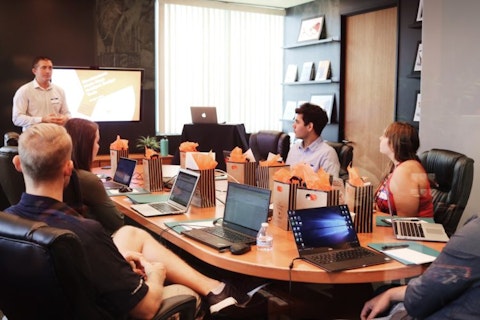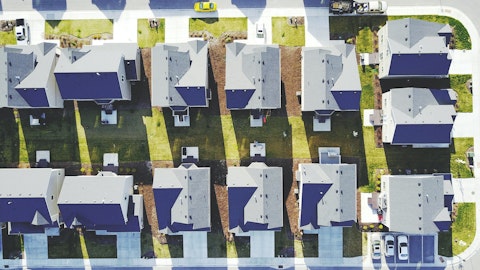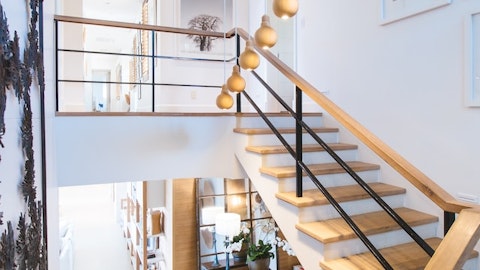Brandywine Realty Trust (NYSE:BDN) Q1 2023 Earnings Call Transcript April 20, 2023
Brandywine Realty Trust reports earnings inline with expectations. Reported EPS is $-0.03 EPS, expectations were $-0.03.
Operator Good day and thank you for standing by. Welcome to the Brandywine Realty Trust First Quarter 2023 Earnings Call. At this time, all participants are in a listen-only mode. After the speaker’s presentation, there’ll be a question-and-answer session. [Operator Instructions] Please be advised that today’s call is being recorded.I’d like to hand the call over to your speaker today, Jerry Sweeney, President and CEO. Please go ahead.Gerard Sweeney Good morning, everyone, and thank you for participating in our first quarter 2023 earnings call. On today’s call with me as usual are George Johnstone, our Executive Vice President of Operations; Dan Palazzo, our Senior Vice President and Chief Accounting Officer, and Tom Wirth, our Executive Vice President and Chief Financial Officer.Prior to beginning, certain information discussed during our call today may constitute forward-looking statements within the meaning of that federal securities law.
Although, we believe estimates reflected in these statements are based on reasonable assumptions, we cannot give assurance that the anticipated results will be achieved. For further information on factors that could impact our anticipated results, please reference our press release, as well as our most recent annual and quarterly reports that we file with the SEC.So to start off with our prepared comments, we’ll review first quarter results and progress in our 2023 business plan. Tom will then review first quarter financial results and frame out some of the key assumptions driving our 2023 guidance for the balance of the year. And after that Dan, George, Tom and I are certainly available to answer any questions. The first quarter has gotten year off to a very solid start, results are in line with our 2023 business plan.
During the quarter, we executed 357,000 square feet of leases, including 179,000 square feet of new leasing activity.For the first quarter, we posted rental rate mark-to-market of 14.9% on a GAAP basis and 4.2% on a cash basis. Our full year mark-to-market range remains 11% to 13% GAAP and 4% to 6% cash. As outlined in our 2023 operating plan, we did have 109,000 square feet of negative absorption for the quarter due to known move out an early termination activity. While quarterly GAAP same-store outperformed and cash same-store slightly underperformed our business plan ranges, we’re keeping our ranges in place based on leases executed but not yet commenced, as well as some forecasted activity.First quarter capital costs were aligned with our business plan about 8% this first quarter, which was excellent for us, tenant retention of 45% was slightly below the bottom end of our full year forecasts fully anticipated.
So we’re maintaining our existing range in our forecasted levels. Core occupancy and lease targets were in line with our business plan. Spec revenue remains $17 million to $19 million, with $12.8 million or 71% at the midpoint achieved. The speculative revenue range represents approximately 1.1 million square feet, of which 628,000 square feet is done, so we’re 57% complete on that metric.From an occupancy and leasing standpoint, our Washington, D.C. portfolio continues to underperform. Conversely, our Philadelphia CBD, University City, Pennsylvania suburbs and Austin portfolios which cover 94% of our NOI are 91% occupied and 92% leased. So fundamentally operating platform is solid with a stable outlook. We have reduced our forward rollover exposure through 2024 to an average of 6.6% and through 2026 to an average of 7.4%.
We continue to see the quality curve thesis play out as our physical tour volume has been very, very encouraging.First quarter physical tours exceeded our 2022 quarterly average by 40% and also exceeded our pre-pandemic levels by 27%, some more tenants are in the market looking for quality space, we think that portends great things for our portfolio going forward. Additionally, during the first quarter, 126,000 square feet by direct result of this flight to quality. Tenant expansions continue to outweigh tenant contractions in the quarter, and we are projecting as we had in 2022 a positive expansion to contraction ratio.Our total leasing for the quarter is up 23% from last quarter, and our pipeline stands at 3.3 million square feet. That pipeline has broken down between 1.3 million square feet on our existing portfolio, so up about 100,000 feet.
And in 2 million square feet on our development projects, which is up 200,000 square feet from last quarter. The 1.3 million square foot existing portfolio pipeline includes approximately 138,000 square feet in advanced stages of lease negotiation. Also for the quarter, the pipeline about 30% of that new deal pipeline, are prospects looking to move of the quality curve.In looking at our EBITDA, our first quarter net debt-to-EBITDA increase from the fourth quarter, but again in line with our business plan, and its occupancy increases during 2023. We anticipate this ratio will decrease to our business plan range, and as we always note and specify in our SIP. This ratio is transitionally higher due to development spend and debt attribution from our joint ventures.

Photo by Campaign Creators on Unsplash
And to further amplify that point, our core EBITDA metric, which is our operating portfolio, excluding joint venture debt attribution, and development and redevelopment spend ended the quarter at 6.4 times within our targeted range.With economic uncertainty and rate volatility at top of mind, leasing and liquidity remain our key focal points, and as Tom will touch on the liquidity front. Since year end, we made significant progress raising over $315 million of proceeds. In January, as previously disclosed, we closed the 5-year $245 million secured financing collateralized by 7 wholly-owned properties. This note, while secured headstock flexible release provisions and free payment provisions after March 2025. And as we noted in our previous call, we took the secure route solely due to pricing differences between secured and unsecured market as we do plan to remain in unsecured investment grade borrower.And then during February, we executed a $70 million unsecured term loan to further bolster our liquidity.
As a result of these and other financings done late last year, our consolidated debt is 93% fixed at 5.1% rate, and we have no consolidated debt maturities until our October 2024 $350 million bond. We continue to have full availability on our $600 million unsecured line of credit and approximately $97 million of unrestricted cash on hand. And it’s noted on Page 13 in our SIP, based on development spend projections, business plan execution, after fully funding remaining development spend in dividends, all TI and leasing costs, we project that full availability on our line of credit at year end 2023.In terms of dividends for the quarter at the guidance midpoint are $0.76 annual dividend or $0.19 per quarter represented a 66% FFO payout ratio and an 81% cash payout ratio.
We had a great quarter controlling capital spend to be conservative for now we are keeping our CAD range in place. Additionally, our business plan projects $100 million to $125 million of sales activity that may generate additional gains.With liquidity needs substantially address our sale activity on target, conservative underpinnings to our coverage ratios. We kept the dividend at $0.19 cents for the first quarter. Certainly as our business plan progresses, the board will closely monitor capital market conditions, overall liquidity, sale activity progress and our payout levels as they evaluate the dividend going forward. We also from an additional liquidity enhancement plan to enter into 2 construction loans this year; one in our 100% fully leased 155 King of Prussia Road and our Life Science project in Schuylkill Yards later this year.On the joint venture front, as disclosed in the SIP, we have two non-recourse loans maturing during 2023.
We are well underway with our refinancing efforts for those loans. The first is a $200 million loan in our Commerce Square joint venture. This is a lower levered financing with over 12% current debt yield, we have received a short-term extension from the existing lender and anticipate closing the new financing during the second quarter. The second maturity occurs in August of 2023, again, non-recourse in a joint venture that we’re 50% partner in and refinancing efforts are underway there as well.In looking at our development pipeline, we currently have $1.2 billion under active development. Of that, our wholly-owned development pipeline of $302 million is 30% life science and 70% Office. This wholly-owned development portfolio is 83% leased, with the remaining funding requirement of $77 million, which is built into our 2023 capital plan.
Our joint venture development is 31% residential, 41% life science and 28% office.Brandywine has now fully funded our equity position, with $52 million of equity remaining to be funded by our partners. Furthermore, other than fully leased build-to-suit opportunities, as I mentioned on the last call future development starts are on hold, pending both more leasing to our existing joint venture pipeline, and also to the point more clarity on the cost of debt capital and cap rates. Looking ahead, though, given a mixed use nature of Master Plan communities primarily of Schuylkill Yards and Uptown ATX, as identified on Page 14 of our SIP, are expected for pipeline product mix is 21% Life Science, 36% residential, 27% office, and 16% support retail and other uses.And overtime is certainly subject to capital market conditions and tenant demand drivers, we do plan to develop about 3 million square feet of life science space.
Upon that completion, we’ll have about 7.5% of our portfolio of square footage in life science, when the existing projects are completed. And our objective is to grow our life science platform, so about 21% of our square footage.Just a quick review of our specific development projects, 2340 Dulles is 92% pre-leased, $33 million are remaining funding is in our capital plan. 250 King of Prussia Road and our Radnor Life Science Center remained 53% leased, we have $28 million of remaining funding, we have a strong pipeline of over 220,000 square feet for the remaining space, and that pipeline is 100% Life Science, and we are still projecting a stabilization date in Q1 2024.3025 JFK, our life science office residential tower is on time and on budget for delivery in the second half of this year.
We have a current active pipeline totaling 625,000 square feet on that project, which is up 153,000 square feet from last quarter. That’s obviously for the life science and office components. The project continues to see great activity as the construction progresses, superstructure now complete lobby finishes are going in. We’ve done over 134 Hard Hat tours. We also expect to start delivery the first block of residential units in the second half of this year, so all remains on schedule there as well.Our dedicated life science building at Schuylkill Yards 3151 Market. We have a pre-leasing pipeline of 423,000 square feet, again up from last quarter. That project will be delivered in the second quarter of 2024. And we have plans underway to obtain a construction loan and that 50% loan to cost range later this year.
Our Block A construction at Uptown ATX is also on time and on budget.On the office component, our leasing pipeline is 538,000 square feet. This pipeline is up from last quarter, and is noted on our last call with some larger tenants putting their requirements on hold. We’re also very much focused on smaller multi-tenant floor prospects. That approach is beginning to bear fruit as our pipeline now its five prospects in the 30,000 to 60,000 square foot range.During the quarter, we also started the next phase of our B.Labs expansion at Cira Center by beginning the conversion of our 9th floor to gradual lab space. That project will be completed in the first quarter of 2024. Total cost is $20 million. The expected yield is about 11%, and we’re already 28% pre-leased.Our 2023 business plan also includes $100 million to $125 million of property dispositions.
We’re making good progress in a challenging market earlier than expected. But we still expect the bulk of the sales activity to occur in the second half of the year. We have $200 million to $300 million of assets in the market for price discovery, as I mentioned. Right now, we have $50 million moving through contract negotiations, and about $75 million nearing the end of the bid solicitation process with several active bidders.We do continue to plan to sell non-core land parcels during the year and on our joint venture operating projects. As I noted in the discussion on EBITDA, about $470 million of debt, or 18% of our total debt levels coming from our JVs with about $420 million of that coming from our operating JVs. We have discussions underway and plan to recapitalize several of these joint ventures later in 2023 with the goal to reduce that attributed debt from operating joint ventures by $100 million, or 24%.
Dollars generated from these liquidity activities will be used to fund our remaining development pipeline, commitments to reduce leverage and redeploying to higher growth opportunities, including stock and debt buybacks on a leveraged neutral basis.At this point, Tom will now provide an overview of our financial results.Thomas Wirth Thank you, Jerry, and good morning. Our first quarter net loss totaled $5.3 million or $0.03 per share, and FFO totaled $50.8 million or $0.29 per diluted share and in line with consensus estimates. Some general observations regarding the first quarter results, while the results were in line with consensus, we have several moving pieces in several variances compared to our fourth quarter call guidance. Our termination and other income totaled $2.4 million, and was up $400 million above our fourth quarter forecast, primarily do some one-time income items.Interest expense totaled $23.7 million or $800,000 below our fourth quarter guidance and is primarily due to this higher capitalized interest.
Our management, leasing and development fees totaled $3.4 million, and was $900,000 above fourth quarter projections primarily due to lease commission income. And we forecasted land sale to generate $1.5 million of gain, one of those transaction was delayed, however, we anticipate that transaction to occur in the second quarter. And our first quarter debt service and interest coverage ratios were 2.9 and 3.1, respectively, and net debt to JV was 41.1%.Our first quarter annualized core net debt-to-EBITDA was 6.4 times within our 2023 range and our annualized combined net debt-to-EBITDA was 7.4 and 0.1 turn above our guidance range of 7 to 7.3. As far as portfolio changes, we anticipate that we will bring 405 into the core portfolio in the second quarter as it stabilizes.
And on the financing side, as Jerry outlined, we continue to make progress on the financing front.In addition to the previously announced transactions, we closed on a $70 million term loan that matures in 24 months, including an extension option, the execution of the term loan provided some additional liquidity to ensure that the $600 million line of credit remains on drawn whether development and redevelopment projects commence operations and begin to provide us incremental cash NOI. While we weren’t successful in obtaining this financing, we continue to see challenges within the financing market.In the traditional banks, we are allocating that – we see them allocating very little to new originations and the new office loan market except for certain situations such as fully elite build-to-suit properties.
We think some lenders will be in to be flexible and will provide loan extensions on performing portfolios.With the Silicon Valley Bank and Signature Bank concerns the CMBS market has been very slow. However, activity has picked up and transactions are focused on lower level loan to value office assets. Life companies have also been selective and underwriting new loans with a focus on lower loan to value and a preference for longer weighted average lease terms. Regarding our joint venture debt, we currently are working on our 2023 maturity, including an active completion of our Commerce Square loan, which will occur – we expect to close later this quarter. We are also working with our partners on the 24 maturities to possibly extend the current maturity dates with our existing lenders, while also considering some asset sales to lower leverage.For 2023 guidance, our general assumptions for the business plan is the property sales, as Jerry mentioned, scheduled to occur in the second half of the year with minimal dilution this year, no property acquisitions, no anticipated ATM or share buyback activity and the share count will approximate 174 million diluted shares.Looking more closely at the second quarter, we have the following general assumptions, our property level operating income to total about $76 million and will be $3.4 million ahead of the first quarter, primarily due to the occupancy in terms 405 Colorado, 250 King of Prussia and the balance from the portfolio.
FFO contribution from [indiscernible] joint ventures with totaled $3.3 million for the second quarter. The sequential decrease is primarily due to the forecast and higher interest expense primarily due to the anticipated refinancing at Commerce Square.G&A for the second quarter will be $9 million, slightly below the first quarter. Total interest expense will approximately $24.7 million and capitalized interest will approximate $3.5. Termination and other fee income will total $0.5 million, a $1.5 million decrease from the first quarter primarily due to several first quarter one-time items that we had highlighted on the last call.Net management fee and leasing development for the quarter will be $2.5 million. This sequential $1 million decrease is primarily due to lower leasing commission volume.
And our land sale gains and tax provision will net at $1.5 million.Looking at our capital plan, we experienced a better than forecasted cash payout ratio of 81%, primarily due to leasing capital costs being below our business plan range. While we experienced some first quarter movement that was lower our annual 2023 cap range remain at 95% to 105%. Our capital plan is very straightforward for the balance of the year. It’s comprised of $130 million of development and redevelopment, $99 million of common dividends it’s currently $22 million of revenue maintain capital, $40 million of revenue create capital and $19 million of equity contributions to our joint ventures.The primary sources will be $148 million of cash flow after interest payments, $42 million use of current cash on hand and $120 million of land and property sales.
Note that we had no cap – based on the capital plan outlined above we project having full line availability by year end. We also projected our net debt to EBITDA will be in the range of 7 to 7.3, with an increase primarily due to the incremental capital spent on development projects.Our net [ph] GAV will be in the range of 40 to 42. And our core net debt to EBITDA of 6.2 to 6.5 at the end of the year, excludes our joint ventures and our active development projects. We continue to believe this core metric that reflects the leverage of our core portfolio and eliminate some more highly leveraged joint ventures and our unstabilized development and redevelopment projects. We believe these processes are elevated on a growing development pipeline and we believe once these developments are stabilized, our leverage will decrease back towards our core leverage ratio.
We anticipate our fixed charge and interest coverage ratios will approximately 2.7 for the year, which represents of potential decrease, but that’s primarily due to higher interest rates.With that, I’ll turn it back over to Jerry.Gerard Sweeney Great. Thank you, Tom. So key takeaways our portfolio is in solid shape, clearly facing some headwinds in the office market. But with pipeline activity is up significantly and advancing through our various stages of leasing efforts at a nice pace. The portfolio is also in a very stable position within average rollovers I mentioned through 26 of only 7.4%. We continue our longstanding track record of posting strong mark-to-markets, managing our capital spend very well.And as I mentioned, some accelerating leasing velocity both in the operating portfolio and the development pipeline as well.
Since last quarter, we’ve made significant progress on our wholly-owned near-term liquidity needs, put ourselves in a very strong liquidity position with zero drawn a line of credit, and $97 million of cash on the balance sheet, and increasingly solid visibility of executing our 2023 business plan that will improve liquidity and keep our operating portfolio in a very strong footing.So, as usual, and where we started, in that we wish all of you and your families well. And at this point, Michelle, we’re delighted to open up for questions, we always ask in the interest of time you limit yourself to one question and a follow-up. Thank you.
See also 35 Most Beautiful Places In The World and 8 Best Insider Trading Websites in 2023.
Question-and-Answer Session Operator Thank you. [Operator Instructions]
And our first question comes from Anthony Paolone with JPMorgan.
Your line is open.Anthony Paolone Great, thank you. I guess, Jerry, my first question relates to just looking at occupancy going forward. I mean, you gave some pretty good stats on expansions versus contractions and the growth in the pipeline. But just trying to see how you bridge that sort of situation with the sentiment that over the next one to two years or whatever it may be? Office cash flows are likely to decline quite a bit, or at least that seems to be the indication from you. The stocks are just, I think, most people’s thinking out there.Gerard Sweeney Hi, Tony. I mean, look, there’s no question that conventional thinking is that there’s going to be some significant, “Hey, was it back some days I wake up, and I think the headwinds are so strong as blowing the hair off my head.” But, no question office is going through, a shift driven by increased employee mobility, shift in space preferences, and there will be winners and losers.
So we definitely expect more selective demand drivers over the next couple of years. And we continue to believe that that tenant, focus will be on quality, driven by superstructure, presentation of building, its location, amenities. Increasingly, we’re seeing more and more that landlord quality and reputation, their ability to fund improvements and their stability in terms of long-term ownership are increasingly up the priority checklist for a lot of our tenants.So even with the secular shifts would seem to be there and the demand muting effective against the slowing economy, we still believe we’ll be in very good position to perform well. I guess, when you take a look at it, there’s a lot of information out there on the office sector, a lot of brokerage firms have good reports out there on the state of the office market.
And, I guess, as we look at it, a recent report was identifying the total office inventory in United States being about 6 billion square feet, about 15% of that being top quality garnering premium rents, about 24% of 1.3 billion, kind of being top-middle very good, and from a competitive standpoint, that 15% kind of attractive to cost conscious consumers. And then the balance they need upgrades repositioning or functionally obsolete.We believe all of our inventories in the top two tiers. So it is going to garner premium rents, where it’s good enough to compete given the location the investment we made. We also think not much is going to be built unless driven by specific demand drivers that over the cycle that will improve the competitive position of our existing inventory.
So that high quality inventory, we think, even with the secular headwinds, their competitive position gets stronger due to supply demand and balance. And I think statistically, you’re starting to see that with even some of the rent disparities between the A and the B space.But we continue to forecast good cash mark-to-market portfolio occupancy and leasing stability, we have excellent control in our capital costs. And even some of the macro statistics after national, which we’re certainly seeing in our own portfolio, there’s no rent premiums on leases greater than 7 years has doubled over the last two years from 16.4% to 35% in Class A inventory. And even the suburbs, new assets are performing better than older assets with rent rates [ph] close to 50%.So when you take a look at CBD new assets over the last couple of years, rents were up 3.6%, while in the Class A trophy class where they’re down 10% in the class date.
Newer assets in the suburbs, rents on average are about 6.8%, and down about 3% in the older quality inventory. So we do think that the office sector is going through a shift, very similar what we saw in some of the other product types, a number of years ago, an 18-foot clear warehouse was state-of-the-art, it’s no longer state-of-the-art.We certainly think that in the office sector, there’ll be some significant accelerated obsolescence, that will have the muting effect on overall demand, but also for the wealth position portfolios, put them in a higher capture rates of bringing in tenants and it seems to be statistically that tenants will continue to pay higher rents to be in a higher quality workplace. Certainly seeing a much more pronounced return to office trend across our portfolio, there’s been some national news on some of the major corporations bringing people back to work, we continue to see very minimal hoteling or hot-desking throughout the portfolio.
So there’s no question conventional thinking is that office is really back on its heels. And we’re positioning the company to deal with that dynamic.We’ve increased our marketing campaign, we’ve increased our investment some of our existing assets. I think the evidence of that is beginning to bear fruit through some of the increase that we’ve seen in our pipeline just in the last couple of months. That pipeline again is advancing through past touring into response RFPs to pay for being interchange. So we’re fully cognizant of the fact that it’s a challenging macro environment, and we have work to do. But we also think that the portfolio repositioning that we’ve done over the last dozen years, has really put the company in a very strong position to weather the storm achieve our business plan objectives, which are conservatively pulled together and use that foundational platform to spring into higher growth as market conditions improved.
I’ll George, anything add to that.George Johnstone No, I mean, great commentary, I think a couple of things, I would – we’re outperforming in just about every sub market in Philadelphia and in the Pennsylvania suburbs, in terms of our overall occupancy as compared to the market. And, even in downtown Philadelphia, including our joint venture holdings that at Commerce Square mean, we’ve got about a 6.6% vacancy factor in a market that’s between 15% and 20% depending on the brokerage research house. So, good levels of outperformance there. I do think the portfolio is situated well to accommodate the trend of people moving up the quality curve. And in terms of our own business plan, we have a path to get us to our occupancy guidance range.But keep in mind the note that Jerry mentioned in his prepared commentary, the small amount of holdings we still have in Northern Virginia and in Wilmington, Delaware are impacting our overall company occupancy by about 170 basis points.





